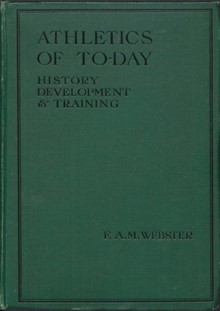A website dedicated to athletics literature / Athletics of To-Day 1929
Athletics of To-Day 1929
F[rederick] A[nnesley] M[ichael] W[ebster]. Athletics of To-day. History, Development and Training, 1929. Foreword by Lord Burleigh (David George Brownlow Cecil, 6th Marquess of Exeter, who was still a successful competing athlete at the time) 1905-1981.
The author:
F.A.M. Webster is one of the most important names in the history of athletics in the 20th century in Britain. His significance does not lie merely in the fact that he wrote more than thirty books on athletics, the Olympic Games, and related topics, nor in the Amateur Field Events Association, and the Loughborough Summer School, both of which he created, nor because he wrote about, taught, and generally championed the field-events in Britain at a time when others didn’t, but because he is an enduring example of how one person, by the power of their own enthusiasm, energy, commitment and persistence, and in the face of the indifference and even hostility of 'official' bodies, can inform, motivate and inspire others, and so leave behind a legacy that lasts long after their own day.
A full biography of FAM Webster, written by his biograndson Michael, can be found here.
The place of Webster's "Athletics of To-day. History, Development and Training" in the history of Athletics literature:
By far the most ambitious of Webster's books to date, this book does pretty much what it says in the title. He wrote it, he said, -
"primarily for the benefit of those young athletes who do not enjoy the benefits of first-class coaching" and with -
"a very real desire to place upon record some history of the development of athletics throughout the world."
It was, he wrote,
"the epitome of a quarter of a century of active participation in athletics, combined with personal experience of
five Olympiads and the close study of athletic technique and conditions in many parts of the globe."
Lord Burghley thought he was one of the most enthusiastic people in athletics, and was "eminently qualified" to write on it. He clearly was.
The text:
Webster takes a panoramic view of Athletics here, reviewing the sport's history in detail and plotting its development. Webster almost always begins his work with history, but he was no historian, and he knew it, modifying his historical statements with such qualifiers as - "it appears", "does not appear", "I believe", "it seems that", "to the best of my knowledge", and so on, but where Webster is particularly valuable is when he reports what he had experienced personally. Such as how London Athletic Club kept athletics alive in Britain during World War I by keeping the Public Schools Championships going; which, paradoxically, led to British athletes at the post-war Olympic Games doing better than those who had gone before.
Webster's enthusiasm for science is a key feature of this book; his acknowledgement of the work of A.V. Hill (Hill's book, "Living Machinery", was only published in 1927) and his frequent use of biomechanical analysis, and mathematics, not as separate sections but to illustrate and inform all of the events, shows Webster to be one of the sport's important thinkers. Incidentally, at one point, he refers to a film of a cat being dropped "back-downwards", and turning in mid-air, landing on its feet, and compares it to a pole-vaulter turning to cross the bar; thirty years later, I saw Geoff Dyson show the same film (and, later, a film of a rabbit) to make much the same point, showing just how long some of Webster's ideas had an impact on the sport and how it was taught.
Webster writes of all the events, including some unfashionable parts of it at the time (ultra-distances, and Low Hurdles), and gives technical analysis and training advice for them all. It is an impressive undertaking, with 368 pages of text, and over 300 illustrations (62 plates and many line drawings in the text, and each plate may have up to 5 individual images).
If this was not impressive enough, Webster includes a statistical Appendix that includes much that is hard to find anywhere else:
World Records (to 7 August 1928)
Olympic Track & Field Champions 1896-1928.
National Records
USA
Great Britain
University Records
Oxford and Cambridge
British Provincial Universities
Oxford and Cambridge Relay Records (1922-1928)
4x100yds, 4x220yds, 4x440yds, 4x880yds, 4x1-Mile,
4x120yds High Hurdles, 4x220yds Low Hurdles.
British Public Schools Championships Records
Services Championships Records
Royal Navy and Marines
Army
Royal Air Force
Table of points in the Track and Field events of the 1928 Olympic Games (Men, Women, and Combined).
Peter Radford / 2016
Bibliographic details:
Title:
Athletics of To-Day
Publisher:
Frederick Warne & Co. Ltd.
Place of Publication:
London
Date of Publication:
1929
BL Catalogue:
General Reference Collection 07911.gg.42
"An Athletics Compendium" Reference:
A78, p.8.



